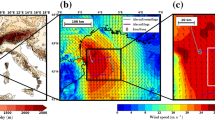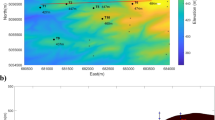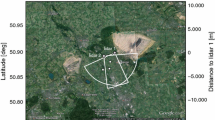Abstract
During the Hydrological-Atmospheric Pilot Experiment (HAPEX)-Sahel, which took place in Niger in the transitional period between the wet and dry seasons, two French aircraft probed the Sahelian boundary layer to measure sensible and latent heat fluxes. The measurements over the Niamey area often revealed organised structures of a few km scale that were associated with both thermals and dry intrusions. We study the impact of these coherent structures using a single day’s aircraft-measured fluxes and a numerical simulation of that day with a mesoscale model. The numerical simulation at high horizontal resolution (250 m) contains structures that evolve from streaks in the early morning to cells by noon. This simulation shows distribution, variance and skewness similar to the observations. In particular, the numerical simulation shows dry intrusions that can penetrate deeply into the atmospheric boundary layer (ABL), and even reach the surface in some cases, which is in accordance with the observed highly negatively skewed water vapour fluctuations. Dry intrusions and thermals organised at a few km scale give skewed flux statistics and can introduce large errors in measured fluxes. We use the numerical simulation to: (i) evaluate the contribution of the organised structures to the total flux, and (ii) estimate the impact of the organised structures on the systematic and random errors resulting from the 1D sampling of the aircraft as opposed to the 2D numerical simulation estimate. We find a significant contribution by the organised structures to the total resolved fluxes. When rolls occur, and for a leg length of about 30 times the ABL depth, the 1D sampled flux is shown to be sometimes 20% lower than the corresponding 2D flux when the 1D sampling direction is the same as the main axis of the rolls, whereas the systematic error is much lower when the direction of the leg is transverse to the rolls. In the case of cells, an underestimate of around 10% can still be observed with the 1D approach independent of direction, due to poor sampling of the energy-containing scales.
Similar content being viewed by others
References
Berg LK and Stull RB (2004). Parametrization of joint frequency distributions of potential temperature and water vapor mixing ratio in the daytime convecctive boundary layer. J Atmos Sci 61: 813–828
Bernard-Trottolo S, Campistron B, Druilhet A, Lohou F and Said F (2003). TRAC08: Detection of coherent structures in a convective boundary layer using airborne measurements. Boundary-Layer Meteorol 111: 181–224
Bougeault P and Lacarrère P (1989). Parametrization of orography-induced turbulence in a mesobeta-scale model. Mon Wea Rev 117: 1872–1890
Couvreux F, Guichard F, Redelsperger JL, Kiemle C, Masson V, Lafore JP and Flamant C (2005). Water–vapour variability within a convective boundary-layer assessed by large-eddy simulations and IHOP-2002 observations. Quart J Roy Meteorol Soc 131: 2665–2693
Couvreux F, Guichard F, Redelsperger JL and Masson V (2007). Negative water vapour skewness and dry tongues in the convective boundary layer: observations and LES budget analysis. Boundary-Layer Meteorol 123(2): 269–294
Cuxart J, Bougeault P and Redelsperger JL (2000). A turbulence scheme allowing for mesoscale and large-eddy simulations. Quart J Roy Meteorol Soc 26: 1–30
Goutorbe JP, Dolman AJ, Gash JHC, Kerr YH, Lebel T, Prince SD, Stricker JNM (1997) HAPEX-Sahel. Elsevier (reprinted from J Hydrol 1079 pp 188–189/1-4)
Grunwald J, Kalthoff N, Fiedler F and Corsmeier U (1998). Application of different flight strategies to determine areally average turbulent fluxes. Contr Atmos Phys 71: 283–302
Halpert MS, Ropelewski CF (1992) Fourth Annual Climate Assessment. Climate Analysis Center. Dept. of Commerce, NOAA/NWS/NMC, 90 pp
Kanda M, Inagaki A, Letzel MO, Raasch S and Watanabe T (2004). Les study of the energy imbalance problem with eddy covariance fluxes. Boundary-Layer Meteorol 110: 381–404
Lacaze R, Donier S, Lacarrère P and Roujean JL (2003). AVHRR-derived land surface conditions for flux simulations with a meso-scale model over the HAPEX-SAHEL study area. J Appl Meteorol 42: 686–700
Lafore JP, Stein J, Asencio N, Bougeault P, Ducrocq V, Duron J, Fischer C, Héreil P, Mascart P, Redelsperger JL, Richard E and Vilà-Guerau de Arellano J (1998). The Meso-NH atmospheric simulation system. Part I: Adiabatic formulation and control simulations. Ann Geophys 109: 16–90
LeMone MA, Zhou M, Moeng CH, Lenschow DH, Miller LJ and Grossman RL (1999). An observational study of wind profiles in the baroclinic convective mixed layer. Boundary-Layer Meteorol 90: 47–82
Lenschow DH, Mann J and Kristensen L (1994). How long is long enough when measuring fluxes and other turbulence statistics. J Atmos Oceanic Technol 11: 661–673
Lenschow DH and Stankov BB (1986). Length scales in the convective boundary layer. J Atmos Sci 43: 1198–1209
Lohou F, Druilhet A and Campistron B (1998). Spatial and temporal characteristics of horizontal rolls and cells in the atmospheric boundary layer based on radar and in situ observations. Boundary-Layer Meteorol 89: 407–444
Lohou F, Druilhet A, Campistron B, Redelsperger JL and Saïd F (2000). Numerical study of the impact of coherent structures on vertical transfers in the atmospheric boundary layer. Boundary-Layer Meteorol 97: 361–383
Mahrt L (1991). Boundary-layer moisture regimes. Quart J Roy Meteorol Soc 117: 151–176
Masson V, Champeaux JL, Chauvin F, Meriguet C and Lacaze R (2003). A global database of land surface parameters at 1-km resolution in meteorological and climate models. J Climate 16: 1261–1282
Noilhan J and Planton S (1989). A simple parametrization of land surface processus for meteorological models. Mon Wea Rev 117: 536–549
Parker DJ, Burton RR, Diongue-Niang A, Ellis RJ, Felton MA, Taylor CM, Thorncroft CD, Bessemoulin P and Tompkins AM (2005). The diurnal cycle of the west African monsoon circulation. Quart J Roy Meteorol Soc 611: 2839–2860
Redelsperger JL and Sommeria G (1986). Three-dimensional simulation of a convective storm: Sensitivity studies on subgrid parameterization and spatial resolution. J Atmos Sci 43: 2619–2635
Saïd F, Attié JL, Bénech B, Druilhet A, Durand P, Marciniak MH and Monteny B (1997). Spatial variability in airborne surface flux measurements during HAPEX-Sahel. J Hydrol 188–189: 878–911
Taylor CM, Harding RJ, Thorpe AJ and Bessemoulin P (1997). A mesoscale simulation of land surface heterogeneity from HAPEX-Sahel. J Hydrol 188–189: 1040–1066
Wai MMK, Smith EA, Bessemoulin P, Culf AD, Dolman AJ and Lebel T (1997). Variability in boundary-layer structure during HAPEX-Sahel wet-dry season transition. J Hydrol 188–189: 965–997
Weckwerth T (1995) A study of horizontal convective rolls occurring within clear-air convective boundary layers. Ph.D. thesis, University of California, Los Angeles
Weckwerth T (1997). Horizontal convective rolls: determining the environmental conditions supporting their existence and characteristics. Mon Wea Rev 125: 505–526
Weckwerth T (1999). An observational study of the evolution of horizontal convective rolls. Mon Wea Rev 127: 2160–2179
Weckwerth T, Parsons DB, Koch SE, Moore JA, Demoz BB, Flamant C, Geers B, Wang J and Feltz WF (2004). An overview of the international H20 project (IHOP_2002) and some preliminary highlights. Bull Am Meteorol Soc 85: 253–277
Williams AG and Hacker JM (1992). The composite shape and structure of coherent eddies in the convective boundary layer. Boundary-Layer Meteorol 61: 213–245
Wyngaard JC (1983). Lectures on the planetary boundary layer. In: Gal-Chen, T and Lilly, DK (eds) Mesoscale meteorology theories, observations and models., pp 781. D. Reidel, Publ. Co., Dordrecht
Author information
Authors and Affiliations
Corresponding author
Rights and permissions
About this article
Cite this article
Lothon, M., Couvreux, F., Donier, S. et al. Impact of coherent eddies on airborne measurements of vertical turbulent fluxes. Boundary-Layer Meteorol 124, 425–447 (2007). https://doi.org/10.1007/s10546-007-9182-9
Received:
Accepted:
Published:
Issue Date:
DOI: https://doi.org/10.1007/s10546-007-9182-9




